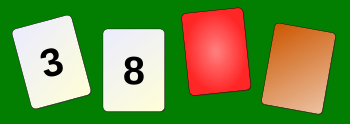Wason selection task facts for kids
The Wason selection task is a famous logic puzzle. It is also known as the four-card problem. Peter Cathcart Wason created this puzzle in 1966. It helps us understand how people use deductive reasoning. This means thinking from general rules to specific conclusions.
Here is an example of the puzzle:
Imagine you see four cards on a table. Each card has a number on one side. It also has a color on the other side. You can see these faces: 3, 8, red, and brown. Your job is to figure out which card or cards you must flip over. You need to check if this rule is true: "If a card shows an even number on one face, then its other face is red."
If you pick a card you don't need to flip, or miss one you do, your answer is wrong. This task is interesting because most people find it hard. But they can solve it easily in certain situations. For example, people often solve it when the rule is about social behavior.
Contents
Solving the Wason Card Puzzle
The correct cards to turn over are the 8 card and the brown card. Let's find out why.
The rule is: "If the card shows an even number on one face, then its opposite face is red." To break this rule, a card must have an even number on one side. And it must have a color that is not red on the other side.
- The 3 card is an odd number. The rule says nothing about odd numbers. So, if it's red or brown, it doesn't break the rule. You don't need to flip it.
- The 8 card shows an even number. If this card is not red on the other side, it breaks the rule. So, you must flip the 8 card.
- The red card is already red. The rule says even numbers must be red. It doesn't say red cards must be even. So, if it's odd or even, it doesn't break the rule. You don't need to flip it.
- The brown card is not red. If this card has an even number on the other side, it breaks the rule. It would be an even number that is not red. So, you must flip the brown card.
Why This Solution Makes Sense
This puzzle uses a type of thinking called classical logic. You need to check two main things to see if the rule is false:
- Check if the "even number" part is true, but the "red" part is false. This means looking for an even number that is not red. That's why you check the 8 card.
- Check if the "red" part is false, but the "even number" part is true. This means looking for a card that is not red (like brown). Then you check if it has an even number. That's why you check the brown card.
Why the Puzzle is Tricky
In Peter Wason's first study, less than 10% of people got the right answer. Other studies in 1993 found the same results.
Some experts think people don't understand "if... then..." in the same way logic does. They might use everyday language, which can be different. However, it's interesting how people react when the correct answer is explained.
One psychologist said that people always understood the logical solution once it was shown to them. They then agreed it was correct. This shows that the puzzle isn't too hard to understand once you know the trick. It just challenges how we naturally think about rules.
See also
 In Spanish: Tarea de selección de Wason para niños
In Spanish: Tarea de selección de Wason para niños


